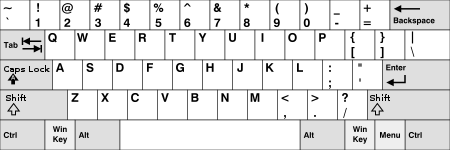| This article needs additional citations for verification. Please help improve this article by adding citations to reliable sources. Unsourced material may be challenged and removed. Find sources: "Menu key" – news · newspapers · books · scholar · JSTOR (July 2016) (Learn how and when to remove this message) |



In computing, the menu key (≣ Menu), or application key, is a key with the primary function to launch a context menu with the keyboard rather than with the usual right-mouse button. It was previously found on Microsoft Windows-oriented computer keyboards and was introduced at the same time as the Windows logo key. On keyboards including the key, its symbol would usually have been a small icon depicting a pointer hovering above a menu; it would typically have been found on the right side of the keyboard between the right Windows logo key and the right control key (or between the right AltGr key and the right control key). While the Windows key is present on the vast majority of keyboards intended for use with the Windows operating system, the menu key was frequently omitted in the interest of space, particularly on portable and laptop keyboards.
It was able to be used when the right-mouse button was not present on a mouse.
Some Windows public terminals did not have a Menu key on their keyboard with the goal of preventing users from right-clicking; however, in many Windows applications, a similar functionality could be invoked with the ⇧ Shift+F10 keyboard shortcut, or sometimes Ctrl+⇧ Shift+F10.
Some laptop computers include a menu function on the fn key (usually operated by typing ⇧ Shift+Fn), however, this generally invokes functions built into the vendor's software and is not the same as the key described above. For example, the Logitech Illuminated Keyboard has an FN key where the menu key is usually found; pressing FN, together with the keyboard's print screen key (above home), produces the Menu key function.
Android devices formerly came with physical menu buttons, but with the release of Android Honeycomb, this was deprecated in favor of an on-screen button.
In January 2024, Microsoft announced a Microsoft Copilot key that would replace the menu key on devices promoted as "AI PCs"—later branded as "Copilot+ PC". If Copilot is disabled or not available in a user's market, this key would launch Windows Search.
See also
References
- "Using your keyboard". support.microsoft.com. Retrieved 2022-06-09.
- "Menus | Android Developers". Developer.android.com. Retrieved 2016-07-17.
- "Say Goodbye to the Menu Button | Android Developers Blog". Android-developers.blogspot.co.uk. 2012-01-26. Retrieved 2016-07-17.
- Kastrenakes, Jacob (2024-05-20). "Microsoft announces Copilot Plus PCs with built-in AI hardware". The Verge. Retrieved 2024-05-20.
- Warren, Tom (2024-03-26). "Microsoft's new era of AI PCs will need a Copilot key, says Intel". The Verge. Retrieved 2024-03-26.
- "Microsoft's new Copilot key is the first big change to Windows keyboards in 30 years". The Verge. Vox Media. January 4, 2024. Retrieved January 6, 2024.
External links
- "Virtual-Key Codes". Winuser.h. Keyboard Input. MSDN. 22 June 2022.
- Menu key at Free Dictionary
| IBM PC keyboard (Windows, ANSI US layout) | ||||||||||||||||||||||||
|---|---|---|---|---|---|---|---|---|---|---|---|---|---|---|---|---|---|---|---|---|---|---|---|---|
| Esc | F1 | F2 | F3 | F4 | F5 | F6 | F7 | F8 | F9 | F10 | F11 | F12 | PrtScn/ SysRq |
Scroll Lock |
Pause/ Break |
|||||||||
 |
Insert | Home | PgUp | Num Lock |
∕ | ∗ | − | |||||||||||||||||
| Delete | End | PgDn | 7 | 8 | 9 | + | ||||||||||||||||||
| 4 | 5 | 6 | ||||||||||||||||||||||
| ↑ | 1 | 2 | 3 | Enter | ||||||||||||||||||||
| ← | ↓ | → | 0 Ins |
. Del | ||||||||||||||||||||
| Keyboard keys | |
|---|---|
| Dead keys | |
| Modifier keys | |
| Lock keys | |
| Navigation keys | |
| Editing | |
| Contextual | |
| Misc. | |
This computer hardware article is a stub. You can help Misplaced Pages by expanding it. |